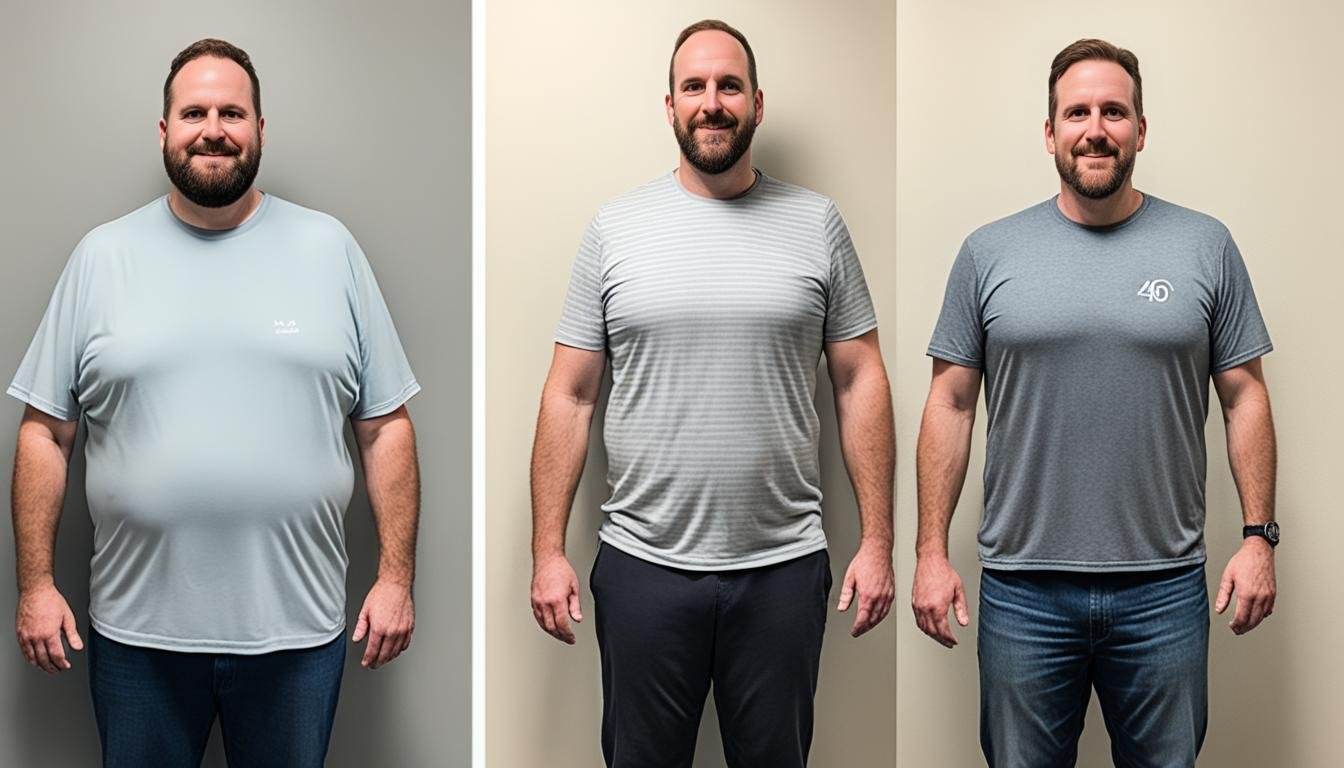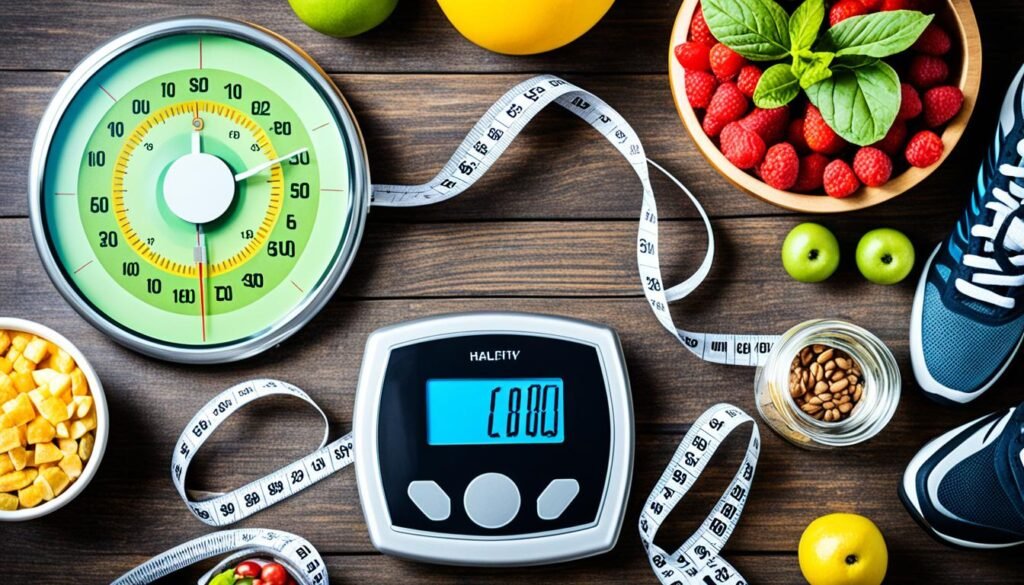Get our FREE E-Book HERE - 120 TIPS for Losing Weight & Bonus Tips for Postpartum Weight Loss & Dad’s Postpartum Experience
How Long Does It Take to Lose 40 Pounds


So, here is the question we hear all the time. How long does it take to lose 40 pounds? The timeline for achieving weight loss goals can vary from person to person, and it’s important to have realistic expectations. In this article, we will explore the average time it takes to lose 40 pounds, the factors that can affect the duration of weight loss, and the best ways to achieve your weight loss goals.
To start, it’s important to understand that weight loss is a gradual process. While it can be tempting to try drastic measures in search of quick results, sustainable weight loss takes time and effort. By adopting healthy habits and staying consistent, you can achieve your goals in a way that is both effective and long-lasting.
Key Takeaways:
- The average time to lose 40 pounds can range from 4-8 months with a healthy and sustainable approach.
- Setting realistic expectations for weight loss is crucial for long-term success.
- Factors such as gender, age, metabolism, and muscle mass can affect the duration of weight loss.
- Personalizing your weight loss plan and working with a healthcare professional or registered dietitian can increase your chances of success.
- A balanced diet and regular exercise are essential components of a successful weight loss journey.
Understanding Weight Loss: Fundamentals and Myths
Before diving into the timeframe for losing 40 pounds, it’s important to understand the fundamentals of weight loss and dispel common myths. One key concept is the caloric deficit, which is the foundation of weight loss. By consuming fewer calories than your body needs, you create a deficit that forces your body to burn stored fat for energy.
However, it’s crucial to distinguish sustainable weight loss methods from fad diets that promise rapid results but may not be healthy or sustainable in the long term. Slow and steady weight loss is often more effective and sustainable, as it allows for healthier eating habits and long-term weight maintenance.
Caloric Deficit: The Science Behind Weight Loss
The concept of a caloric deficit is simple yet powerful. When you consume fewer calories than your body needs, it must tap into its stored energy reserves (fat) to make up the difference. This process leads to weight loss over time.
When aiming for a caloric deficit, it’s important to strike a balance. Extremely low-calorie diets can be counterproductive, as they often result in muscle loss and a slowed metabolism. It’s crucial to create a moderate caloric deficit that allows for healthy and sustainable weight loss.
The Math Behind Losing 40 Pounds
Losing weight involves creating a calorie deficit, which means consuming fewer calories than your body expends over time. To lose one pound of body weight, you need to create a calorie deficit of approximately 3,500 calories. Therefore, to lose 40 pounds, you would need to create a total calorie deficit of:
40 pounds * 3,500 calories/pound = 140,000 calories
Now, let’s calculate the timelines for losing 40 pounds under the two scenarios:
a) Eating 500 calories below Total Daily Energy Expenditure (TDEE): Continuing with the same example TDEE of 2,000 calories per day, eating 500 calories below TDEE would mean consuming 1,500 calories per day.
To calculate the timeline for losing 40 pounds: 140,000 calories / 500 calories per day = 280 days
It would take approximately 280 days to lose 40 pounds eating 500 calories below their TDEE.
b) Eating 800 calories below Total Daily Energy Expenditure (TDEE): Using the same TDEE of 2,000 calories per day, consuming 800 calories below TDEE would equate to consuming 1,200 calories per day.
To calculate the timeline for losing 40 pounds: 140,000 calories / 800 calories per day = 175 days
It would take approximately 175 days to lose 40 pounds eating 800 calories below their TDEE.
So, how long does it take to lose 40 pounds? Based on the two aforementioned examples, it all depends.
If you need to know what is your TDEE, use the calculator below and set your goal as “Maintain Weight”. If want to know more about this calculator follow our detailed instructions on our Calories Calculator Page
Distinguishing Fad Diets from Sustainable Weight Loss
Fad diets often promise quick and dramatic weight loss results, but they often rely on extreme restrictions, eliminating entire food groups, or consuming specific “magic” foods. While they may produce short-term weight loss, the sustainability and long-term health effects are questionable.
In contrast, sustainable weight loss focuses on establishing healthy eating habits and making long-term lifestyle changes. A balanced diet that includes a variety of nutrient-dense foods is key to sustainable weight loss. It’s important to prioritize whole grains, lean proteins, fruits, vegetables, and healthy fats as part of a well-rounded eating plan.
The Myth of Rapid Weight Loss: Why Slower Can Be Better
Rapid weight loss can be alluring, especially when there’s a target event or special occasion on the horizon. However, it’s essential to recognize that sustainable weight loss takes time. While the initial weight loss may be slower, it sets the foundation for healthy habits and long-term success.
Slower weight loss allows your body to adapt to the changes and helps you develop sustainable habits, such as making healthier food choices and incorporating regular physical activity into your routine. Remember, the goal is not just to lose weight but to maintain a healthy weight and overall well-being for the long term.
Setting Expectations: Average Time to Lose 40 Pounds
When embarking on a weight loss journey, it’s crucial to set realistic expectations. While it’s natural to desire quick results, it’s important to understand that weight loss is not an overnight process. It takes time and effort to achieve your goals.
On average, it is considered healthy and sustainable to lose 1-2 pounds per week. This means that if you aim to lose 40 pounds, it may take approximately 20-40 weeks or 4-8 months. However, it’s essential to remember that individual factors can influence the duration of weight loss.
Everyone’s weight loss journey is unique, and various factors such as metabolism, genetics, and lifestyle can impact the rate at which you shed pounds. Therefore, it’s crucial to focus on setting realistic and achievable goals that align with your specific circumstances.
By embracing a long-term mindset and aiming for sustainable weight loss, you can create healthy habits that will support your journey. Patience, consistency, and perseverance will be key to achieving your desired results.
To stay motivated and on track, celebrate small victories along the way and regularly reassess your progress. Remember, the ultimate goal is not just to lose weight but also to achieve overall well-being and a healthier lifestyle.

Factors Affecting Weight Loss Duration
Several factors can influence the duration of weight loss and the time it takes to lose 40 pounds. These factors include gender, age, metabolism, and muscle mass. Understanding how these factors interact can help you develop an effective weight loss strategy.
The Impact of Gender on Weight Loss
Men and women may have different physiological responses to weight loss efforts. Men often have higher muscle mass and a higher metabolic rate, which can contribute to faster weight loss. This is because muscle burns more calories at rest compared to fat. Women, on the other hand, may experience weight loss at a slower pace due to hormonal differences and lower muscle mass on average. However, it’s important to note that individual variances exist, and each person’s weight loss journey is unique.
How Age Influences Weight Loss Efficiency
Age can also affect weight loss efficiency. As we get older, our metabolism tends to slow down, making it harder to lose weight. Additionally, muscle mass naturally decreases with age, which further decreases our daily calorie burn. These age-related changes can impact the duration of weight loss, requiring more time and effort to achieve desired results.
Metabolism and Muscle Mass: Their Roles in Your Weight Loss Journey
Metabolism and muscle mass play essential roles in weight loss. A higher metabolism means your body burns more calories at rest, making it easier to create a calorie deficit and lose weight. Similarly, having more muscle mass increases your daily calorie burn. This is because muscle tissue requires more energy to maintain compared to fat tissue. By focusing on increasing your metabolism and building lean muscle through resistance training, you can accelerate your weight loss progress.

Understanding these factors can help you tailor your weight loss strategy to your unique circumstances. While gender, age, metabolism, and muscle mass can influence the duration of weight loss, it’s important to remember that sustainable weight loss is a gradual process. By adopting healthy eating habits, engaging in regular physical activity, and seeking guidance from healthcare professionals or registered dietitians, you can create a personalized weight loss plan that sets you up for long-term success.
How Long Does It Take to Lose 40 Pounds: Personalizing Your Plan
While there is an average timeframe for losing 40 pounds, it’s important to remember that each person’s weight loss journey is unique. Personalizing your weight loss plan is key to success. Factors such as starting weight, current lifestyle, dietary preferences, and activity level can all impact the timeline for reaching your weight loss goals. By working with a healthcare professional or registered dietitian, you can create an individualized weight loss approach that takes into account your specific needs and goals. This personalized plan can help you stay motivated and achieve a personalized weight loss timeline that is both effective and sustainable.
To personalize your weight loss plan, consider factors such as:
- Starting weight: Your starting weight can indicate the amount of weight you may need to lose and can impact the duration of your weight loss journey.
- Current lifestyle: Assess your daily routine, including work, family, and social commitments, to determine how to incorporate healthy habits into your lifestyle.
- Dietary preferences: Identify the types of foods you enjoy and explore ways to incorporate them into a balanced and nutritious meal plan.
- Activity level: Evaluate your current level of physical activity and consider how to increase it gradually over time to support your weight loss goals.
By taking these factors into account, you can tailor a weight loss plan that aligns with your preferences, lifestyle, and goals. This individualized approach ensures that you are more likely to stick with your plan and achieve long-term success.
How Long Does It Take to Lose 40 Pounds As A Woman?
When it comes to weight loss, women may have unique considerations due to biological factors such as hormonal differences and lower muscle mass on average. As a result, women may experience weight loss at a slower pace compared to men.
However, women need to remain patient and focus on sustainable weight loss methods. By creating a balanced diet that includes nutrient-dense foods and engaging in regular physical activity, women can achieve their weight loss goals over time.
Remember, sustainable weight loss takes time and commitment. It’s not about losing weight quickly, but rather about creating healthy habits that you can maintain in the long run. By prioritizing overall health and well-being, you can achieve your weight loss goals and live a healthier, happier life.

How Long Does It Take to Lose 40 Pounds As A Man?
As a man, you may experience weight loss at a faster pace compared to women due to your higher muscle mass and metabolic rate. These advantages can contribute to a quicker weight loss journey. However, it’s important to note that individual factors such as your starting weight, lifestyle, and overall health can still influence the duration of your weight loss.
To achieve your weight loss goals, it is crucial to focus on creating a sustainable plan that includes a balanced diet and regular physical activity. A balanced diet will provide your body with the necessary nutrients while ensuring a calorie deficit for weight loss. Incorporating whole grains, lean proteins, fruits, vegetables, and healthy fats into your diet will help you maintain energy and support your weight loss efforts.
While exercise is essential for overall health and weight loss, it’s important to find activities that you enjoy and can sustain long-term. Regular physical activity, which includes both cardiovascular exercise and strength training, will help you burn calories and build lean muscle mass.
By adopting healthy habits, staying consistent, and personalizing your weight loss plan, you can achieve your weight loss goals within a reasonable timeframe. Remember to consult with a healthcare professional or registered dietitian to develop a plan that fits your unique needs and goals.
Now, let’s explore the role of diet and exercise in shedding weight and how you can create a balanced approach that leads to long-term success.
How Long Does It Take to Lose 40 Pounds If I Don’t Eat?
Extreme measures, such as drastically limiting calorie intake or not eating at all, are not recommended for healthy and sustainable weight loss. Not eating enough calories can lead to nutritional deficiencies, muscle loss, and other health risks.
It’s important to prioritize a balanced and nutritious diet that provides sufficient energy and nutrients for your body’s needs. Working with a healthcare professional or registered dietitian can help you create a safe and effective weight loss plan that promotes overall health and well-being.
The Role of Diet and Exercise in Shedding Weight
Creating a Balanced Diet for Long-Term Success
When it comes to weight loss, diet plays a crucial role. To achieve long-term success, it is essential to create a balanced diet that includes a variety of nutrient-dense foods. Incorporate lean proteins, whole grains, fruits, vegetables, and healthy fats into your meals. These foods provide essential nutrients, help you feel satisfied, and support your overall health.
Physical Activity: How Much is Needed to Reach Your Goal
In addition to a balanced diet, physical activity is a key component of weight loss. Engaging in regular exercise helps burn calories, improve cardiovascular health, and increase metabolism. The amount of physical activity needed varies from person to person, but a general guideline is to aim for at least 150 minutes of moderate-intensity aerobic activity per week. This can include activities like brisk walking, cycling, or swimming.
Intensity vs. Duration: What’s More Effective for Weight Loss?
When planning your exercise routine, it’s important to consider the balance between intensity and duration. High-intensity workouts, such as interval training or HIIT workouts, can maximize calorie burn in a shorter amount of time. On the other hand, longer durations of moderate-intensity exercise, like jogging or dancing, can also be effective for weight loss. Ultimately, finding the approach that works best for you and fits into your lifestyle is key.
You can optimize your weight loss journey by incorporating a balanced diet and regular exercise into your routine. Remember, everyone’s body is different, so it’s important to listen to your body and make adjustments as needed. Stay consistent and focused on your goals, and you’ll be on your way to shedding weight and achieving a healthier lifestyle.
Conclusion
In conclusion, the timeline for losing 40 pounds can vary depending on individual factors, but on average, it may take around 4-8 months with a healthy and sustainable approach. It’s important to set realistic expectations and understand that weight loss takes time and effort. By personalizing your plan and incorporating a balanced diet and regular exercise, you can achieve long-term success in reaching your weight loss goals.
Remember to consult with a healthcare professional or registered dietitian to develop a plan that fits your unique needs and goals. They can provide valuable guidance and support throughout your weight loss journey. With their expertise, you can create a personalized approach that takes into account your specific circumstances and maximizes your chances of success.
Patience, consistency, and a focus on overall health are key in your weight loss journey. It’s not just about the number on the scale, but also about adopting healthy habits that can be maintained in the long run. By making sustainable lifestyle changes, you can not only achieve your weight loss goals but also maintain a healthier lifestyle for years to come. Remember, it’s a journey, and every step you take towards a healthier you is an accomplishment.
FAQ
Q: How long does it typically take to lose 40 pounds?
A: On average, it may take around 20-40 weeks, or 4-8 months, to lose 40 pounds with a healthy and sustainable approach.
Q: What are the fundamentals of weight loss?
A: Weight loss is achieved by creating a caloric deficit, which means consuming fewer calories than your body needs. This forces your body to burn stored fat for energy.
Q: How can I distinguish sustainable weight loss methods from fad diets?
A: Sustainable weight loss focuses on slow and steady progress, emphasizing healthy eating habits and long-term weight maintenance. Fad diets often promise rapid results but may not be healthy or sustainable.
Q: Is slow weight loss more effective and sustainable?
A: Yes, slow and steady weight loss is often more effective and sustainable as it allows for healthier habits and long-term weight maintenance.
Q: What is a realistic timeframe for losing 40 pounds?
A: It is considered healthy and sustainable to lose 1-2 pounds per week. Therefore, it may take around 20-40 weeks, or 4-8 months, to lose 40 pounds.
Q: What factors can affect the duration of weight loss?
A: Factors such as gender, age, metabolism, muscle mass, starting weight, lifestyle, and overall health can influence the duration of weight loss.
Q: How can I personalize my weight loss plan?
A: Personalizing your weight loss plan involves considering your specific needs and goals, including factors such as starting weight, current lifestyle, dietary preferences, and activity level.
Q: How long will it take for a woman to lose 40 pounds?
A: Women may experience weight loss at a slower pace compared to men due to hormonal differences and lower muscle mass on average. However, with a balanced diet, regular physical activity, and overall health focus, women can achieve their weight loss goals over time.
Q: How long will it take for a man to lose 40 pounds?
A: Men may experience weight loss at a faster pace compared to women due to higher muscle mass and metabolic rate. However, individual factors such as starting weight, lifestyle, and overall health can still influence the duration of weight loss.
Q: Is not eating recommended for weight loss?
A: No, extreme measures such as drastically limiting calorie intake or not eating at all are not recommended for healthy and sustainable weight loss. Proper nutrition is crucial for overall health.
Q: How important is diet and exercise in shedding weight?
A: Both diet and exercise play important roles in weight loss. A balanced diet that includes a variety of nutrient-dense foods is crucial for long-term success. Regular physical activity helps burn calories and promotes overall health.







